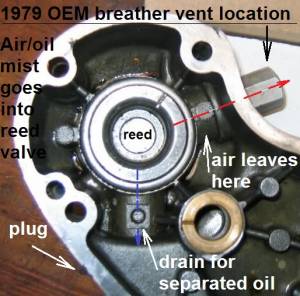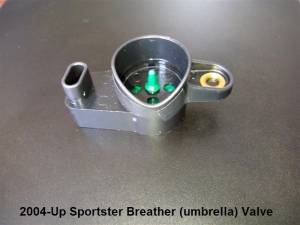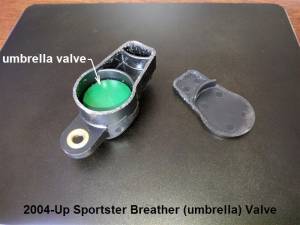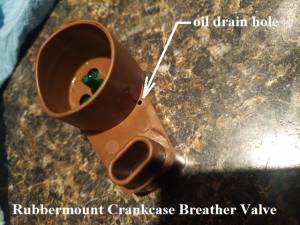REF: Engine Mechanicals - Sub-07H
Oil Drainback and Supplemental Air Intake from Breather Valves
Vacuum is created in the bottom end on 1957-present engines due to piston upstroke (actually that's the same in any internal combustion engine).
The volume of air under them increases without any or much air intake behind to fill the void.
This leaves a lower differential pressure underneath and measured as negative pressure (or vacuum).
1957-1976 Sportster engines use a timed rotary breather valve to control when and how much vacuum is created in the crankcase.
As pistons begin to rise, the valve is still open. So vacuum is not built until after the valve closes farther up the cylinder.
When pistons rise, vacuum is created under them and air pressure is brought into the crankcase from the gearcase vent until the breather closes.
So there is an air intake into the crankcase from atmosphere until the valve closes.
1979-up Sportster engines use a one way breather valve and the breather valve assemblies all have a tiny oil / air drainback hole.
It's installed on the outside of the breather valve.
- The breather valve has a built in pocket in the cam cover (see pics below).
- Air / oil mist enters the pocket and flows past the valve.
- Just past the valve (between it and the vent outlet) is another smaller chamber. That is the final separation chamber for air and oil.
- Oil droplets fall out of suspension there and down into a small hole between the valve and the cover.
The drain leads back into the (cam chest - pre 91) or (rocker box - post 91). - Air in that small chamber is sent out the 10:00 vent hole in the cam cover (pre 91) or head vents (post 91).
- The bottom of the separation chamber where it says “reed” in the pic below is not really the bottom of the chamber.
There is a space (final separation chamber) behind the reed (between the reed and the cover).
That is where oil droplets are pulled back into the gearcase that make it past the reed.
Vacuum in the bottom end pulls oil from that chamber back into the gearcase.
- At the same time, the air is purged out the vent hose.
The final separation chamber doesn't need to be very big.
And the drain hole doesn't need to be very big either, else you suck more air back and change the pressure balance.
The drainback hole has a couple functions.
- Engine vacuum pulls the oil that gets past the valve back into the engine thru the drain hole.
- The drain pulls in a slight amount of atmosphere to assist in removing the oil from the separation chamber.
You have to have air intake on the back side of suction to fill the void when the oil is removed.
If there is no oil left in the chamber to remove, air is pulled in the drain hole from the outside.
And that will affect overall vacuum control.
The MoCo had these little things ironed out pretty well. They predetermined the drain size so it would act as intended and not derail the pressure.
1979-1990 engines have a hollow runner with a plug at the 6 O'clock position with the cam cover installed.
There is a dimple on that runner with the oil drain hole drilled into it.
See pics below;
The 77 breather compartment in the cover below has oil drainback hole in the cover (wouldn't work if it was there anyway).
The 81 cover was fitted with the rubber breather umbrella upgrade (26909-79A) which is not important to this discussion.
But, see the bossed area below where the breather is usually installed. There is a runner going down with a dimple and a tiny hole in the dimple.
That is the oil drain hole. It is a very small hole and oil just can't drain from there too fast without vacuum to pull it out.
The 85 cover has the breather baffle tube system but the principles are the same and it doesn't appear the drain hole size changed.
| 77 Cam Cover Breather Compartment (no oil drainback). 1) | 81 Cam Cover Breather Compartment (w / rubber umbrella valve upgrade) Oil drainback hole in dimple. 2) | 85 cam cover w / baffle tube system. Oil drainback in dimple. 3) |
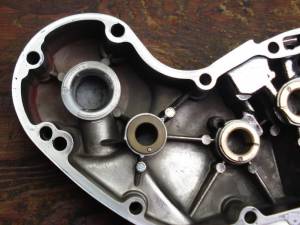 | 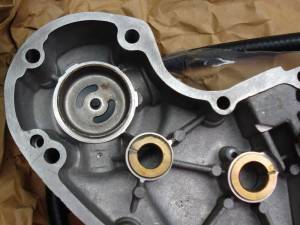 | 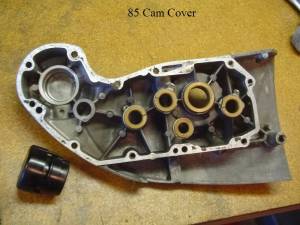 |
91-up engines breath from the heads instead of the cam cover but the principles are the same.
The drain hole in the 98 chamber appears to be slightly bigger than that in the cam covers.
| 98 Rocker Box Breather Compartment. 4) |
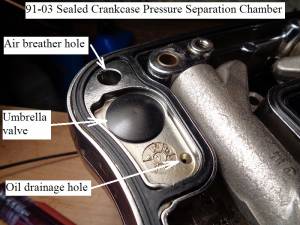 |
In 2004-up engines, the umbrella was encapsulated in a plastic housing (removing the need to create the separation chamber in the rocker box casting).
The final separation chamber is now in the breather valve assembly (past the valve and before the vent as before).
The assembly was cut open in the pics below revealing the separation chamber and the drain hole.

